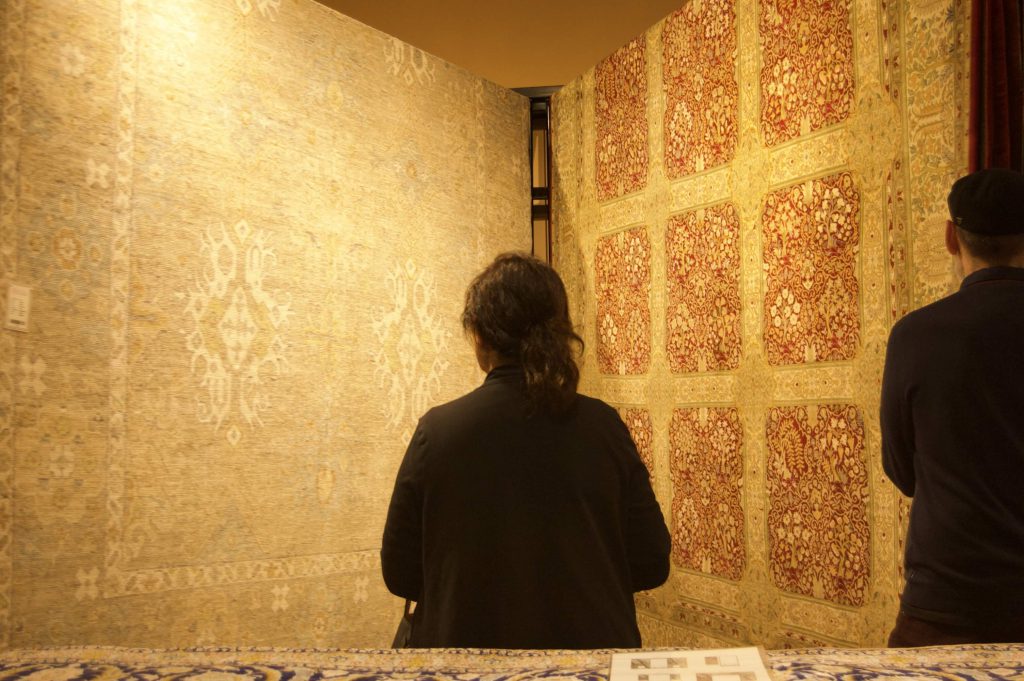
The rug is an emblem of Persian culture. Families place them on their living room floors and, at times, hang them from their walls. It’s a celebration of beauty, and can be a mark of decadence.
Babak Falasiri, the owner of Serapi Rug Gallery for the last 15 years, has been in the industry for three decades in the United States. At one point during a three-hour interview with the Los Gatan—as Falasiri explained the intricacies of the rug-making craft—a shopper came in and purchased thousands of dollars worth of rugs on the spot. It was a joyous moment for Falasiri, who said such a quick (and lucrative) sale happens maybe three times a year.
The introduction of luxury rugs at the start of the recession was discouraged by many of Falasiri’s colleagues at the time. But several years later, Falasiri’s success—a product of personal and professional resilience—speaks for itself.

Some rugs are so luxurious they could match what someone would put down for an initial mortgage payment. The care that goes into each product is what makes them stand out. There’s a story behind each one. And, Falasiri says, when taken care of properly, these high-quality items will stay in a family for multiple generations.
Falasiri, who grew up in Iran, has been selling rugs for most of his life. He began this journey at just 17 in Miami, Fla., with his two uncles. He felt Silicon Valley calling, and he moved to Los Gatos in 2007 with his wife.
Iran has compulsory military service for young men, but fortunately for Falasiri, he moved to St. Louis, Mo., at the age of 13 to live with relatives. When he was 15, he moved to Los Angeles, attending Hoover High. After graduating, Falasiri wanted to work with his uncles in Miami, because Persian rugs were part of his culture. The jump felt familiar to him.

(Faizi Samadani / Los Gatan)
Since attending college in Florida and moving into the workforce, Falasiri has been working steadily in the business for decades. “I was living in Florida for 16 years with my uncles, so I started learning the very basics,” he says. “I put my youth in that and helped their business grow.” While working for his uncles, Falasiri would sit at the store between sales and dream about starting a similar company.
He recalls that his uncles’ business, Shiraz Rug Gallery, was the biggest rug retailer in the southeastern United States at the time. He didn’t know how to go about opening such an operation, but he would imagine the possibilities. Around 2007, his relationship with his uncles had begun to fray. He decided it was time to strike out on his own. This very quickly led him to move to California with his wife to open his own shop right in Los Gatos. One of Falasiri’s brothers teaches at York University in Toronto, Canada, while the other is a coffee shop owner in Beverly Hills. But Falasiri wanted to follow his own path.

(Faizi Samadani / Los Gatan)
Product longevity
Rugs that are eight feet by 10 feet are the best-selling size rugs at Serapi Rugs, and take two years to weave, on average. But some can take up to seven to 12 years. Falasiri highlights this in relation to the ongoing tariffs, insinuating that these rugs couldn’t feasibly be produced in America. “I don’t know how it’s going to end up, but it’s definitely going to end up affecting us,” he says. “I understand the concept behind it, for sure. But, I think there has to be revisions, because this is a handmade art. The craftsmanship is such that, in these countries, it’s an infrastructure that’s been built over centuries.”
The tapestry business isn’t as affected by wars and government shutdowns as other forms of commerce might be. Their busiest time is the back-to-school and fall season. But no matter the time of year, Falasiri says he’s always looking for rugs that have artistic merit. “We have tribals and classic designs with an Old World pattern,” he said. “We have antique rugs that are over 100 years old, then modern and traditional rugs.” Most rugs cost under $10,000—though there are exceptions that are much higher than that number.
Falasiri looks to import his rugs directly, to avoid having to deal with a middle-man. Usually, it’s not the weaver who makes the lion’s share of the money. Rather, it’s the presenter. “What you see here, 90% of the rugs are directly imported from the producer that works with the weaver,” he says. “We import from Nepal, India, Afghanistan, Pakistan, Turkey, and we used to import a lot from Iran. But now there are sanctions, which most recently happened in 2018.” Falasiri has rugs sourced from Iranian cities, but also from small towns and tribal areas. “Some of my prize possessions are the genuine Persian tribal and village rugs,” he says.
“I love the Qashqaii rugs—which is located close to the city of Shiraz. In my mid-20s, I focused on building relationships with people, so that’s how I started the business.” Falasiri doesn’t know the tribes personally, but he’s built relationships with those who do. And he’s very picky about building his collection.
Falasiri says Persian rugs aren’t just a luxury, they’re also fine art pieces that can be considered an investment—something that’s impossible to replicate.









